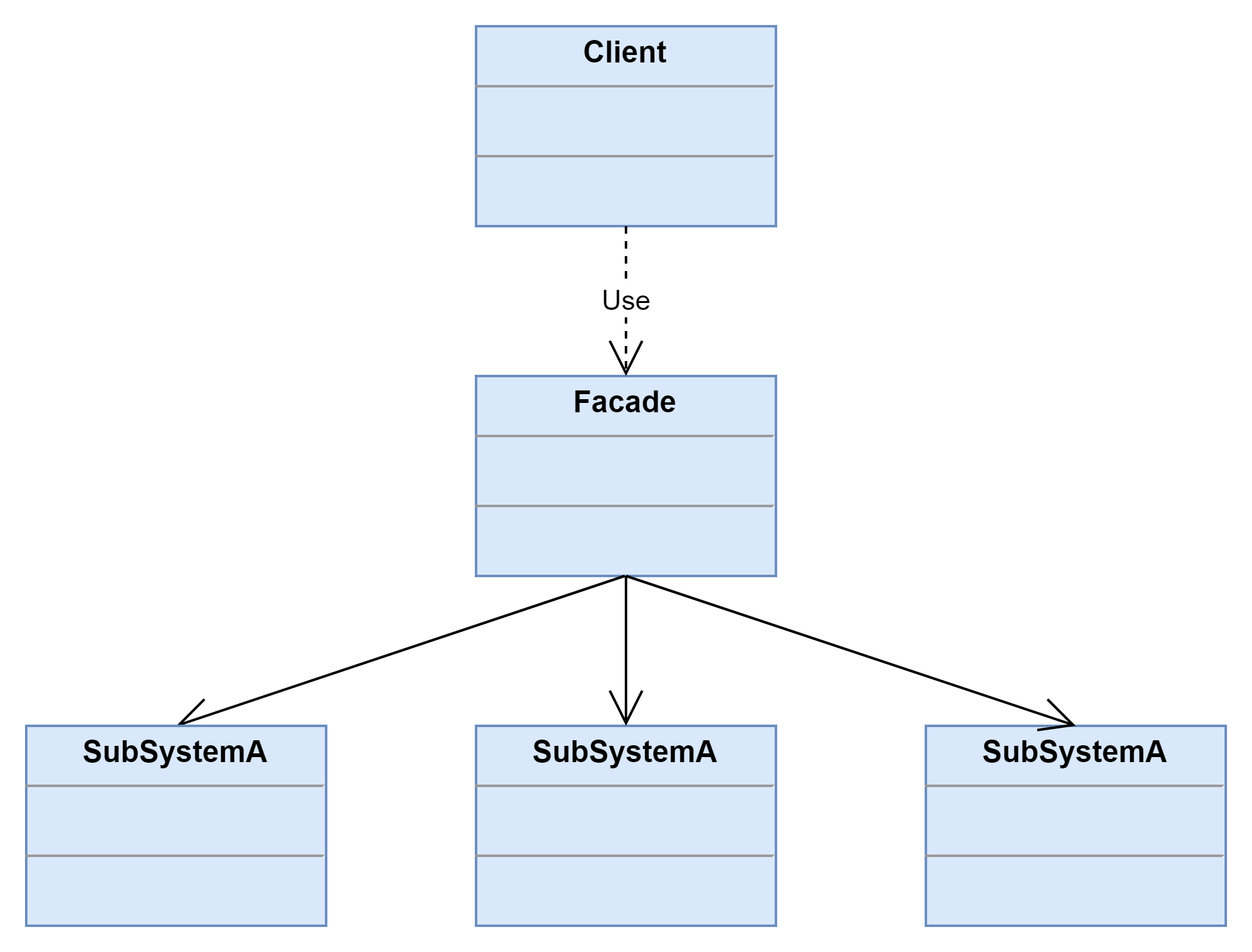外观模式 (Facade Pattern)
为子系统中的一组接口提供一个统一的入口。外观模式定义了一个高层接口,这个接口使得这一子系统更加容易使用。
外观模式中,一个子系统的外部与其内部的通信通过一个统一的外观类进行,外观类将客户类与子系统的内部复杂性分隔开,使得客户类只需要与外观角色打交道,而不需要与子系统内部的很多对象打交道。
结构图
- Facade(外观角色):在客户端可以调用它的方法,在外观角色中可以知道相关的(一个或者多个)子系统的功能和责任;在正常情况下,它将所有从客户端发来的请求委派到相应的子系统去,传递给相应的子系统对象处理。
- SubSystem(子系统角色):在软件系统中可以有一个或者多个子系统角色,每一个子系统可以不是一个单独的类,而是一个类的集合,它实现子系统的功能;每一个子系统都可以被客户端直接调用,或者被外观角色调用,它处理由外观类传过来的请求;子系统并不知道外观的存在,对于子系统而言,外观角色仅仅是另外一个客户端而已。
示例
using System;
namespace DesignPatterns.Facade
{
// The Facade class provides a simple interface to the complex logic of one
// or several subsystems. The Facade delegates the client requests to the
// appropriate objects within the subsystem. The Facade is also responsible
// for managing their lifecycle. All of this shields the client from the
// undesired complexity of the subsystem.
public class Facade
{
protected Subsystem1 _subsystem1;
protected Subsystem2 _subsystem2;
public Facade(Subsystem1 subsystem1, Subsystem2 subsystem2)
{
this._subsystem1 = subsystem1;
this._subsystem2 = subsystem2;
}
// The Facade's methods are convenient shortcuts to the sophisticated
// functionality of the subsystems. However, clients get only to a
// fraction of a subsystem's capabilities.
public string Operation()
{
string result = "Facade initializes subsystems:\n";
result += this._subsystem1.operation1();
result += this._subsystem2.operation1();
result += "Facade orders subsystems to perform the action:\n";
result += this._subsystem1.operationN();
result += this._subsystem2.operationZ();
return result;
}
}
// The Subsystem can accept requests either from the facade or client
// directly. In any case, to the Subsystem, the Facade is yet another
// client, and it's not a part of the Subsystem.
public class Subsystem1
{
public string operation1()
{
return "Subsystem1: Ready!\n";
}
public string operationN()
{
return "Subsystem1: Go!\n";
}
}
// Some facades can work with multiple subsystems at the same time.
public class Subsystem2
{
public string operation1()
{
return "Subsystem2: Get ready!\n";
}
public string operationZ()
{
return "Subsystem2: Fire!\n";
}
}
class Client
{
// The client code works with complex subsystems through a simple
// interface provided by the Facade. When a facade manages the lifecycle
// of the subsystem, the client might not even know about the existence
// of the subsystem. This approach lets you keep the complexity under
// control.
public static void ClientCode(Facade facade)
{
Console.Write(facade.Operation());
}
}
class Program
{
static void Main(string[] args)
{
// The client code may have some of the subsystem's objects already
// created. In this case, it might be worthwhile to initialize the
// Facade with these objects instead of letting the Facade create
// new instances.
Subsystem1 subsystem1 = new Subsystem1();
Subsystem2 subsystem2 = new Subsystem2();
Facade facade = new Facade(subsystem1, subsystem2);
Client.ClientCode(facade);
}
}
}运行结果
1
2
3
4
5
6
Facade initializes subsystems:
Subsystem1: Ready!
Subsystem2: Get ready!
Facade orders subsystems to perform the action:
Subsystem1: Go!
Subsystem2: Fire!
总结
外观模式是一种使用频率非常高的设计模式,它通过引入一个外观角色来简化客户端与子系统之间的交互,为复杂的子系统调用提供一个统一的入口,使子系统与客户端的耦合度降低,且客户端调用非常方便。外观模式并不给系统增加任何新功能,它仅仅是简化调用接口。在几乎所有的软件中都能够找到外观模式的应用,如绝大多数B/S系统都有一个首页或者导航页面,大部分C/S系统都提供了菜单或者工具栏,在这里,首页和导航页面就是B/S系统的外观角色,而菜单和工具栏就是C/S系统的外观角色,通过它们用户可以快速访问子系统,降低了系统的复杂程度。所有涉及到与多个业务对象交互的场景都可以考虑使用外观模式进行重构。
优点
- 它对客户端屏蔽了子系统组件,减少了客户端所需处理的对象数目,并使得子系统使用起来更加容易。通过引入外观模式,客户端代码将变得很简单,与之关联的对象也很少。
- 它实现了子系统与客户端之间的松耦合关系,这使得子系统的变化不会影响到调用它的客户端,只需要调整外观类即可。
- 一个子系统的修改对其他子系统没有任何影响,而且子系统内部变化也不会影响到外观对象。
缺点
- 不能很好地限制客户端直接使用子系统类,如果对客户端访问子系统类做太多的限制则减少了可变性和灵活性。
- 如果设计不当,增加新的子系统可能需要修改外观类的源代码,违背了开闭原则。
适用场景
- 当要为访问一系列复杂的子系统提供一个简单入口时可以使用外观模式。
- 客户端程序与多个子系统之间存在很大的依赖性。引入外观类可以将子系统与客户端解耦,从而提高子系统的独立性和可移植性。
- 在层次化结构中,可以使用外观模式定义系统中每一层的入口,层与层之间不直接产生联系,而通过外观类建立联系,降低层之间的耦合度。
This post is licensed under CC BY 4.0 by the author.
